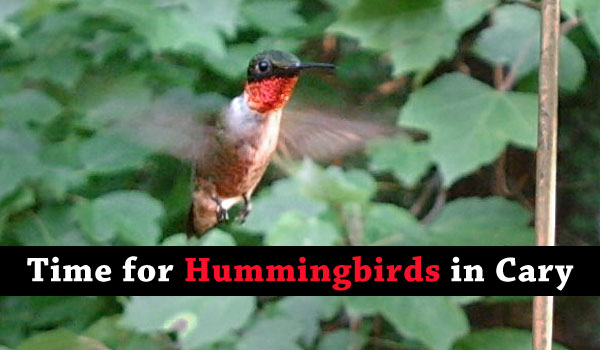Time for Hummingbirds in Cary
Story and photo by David Lindquist, chairperson of the Town of Cary Parks & Recreation advisory board.
Cary, NC – Who doesn’t enjoy watching hummingbirds? Fortunately, we have the opportunity to enjoy these tiny but wonderful birds every summer right here in the Triangle.
Ruby Throated Hummingbirds
The Ruby Throated Hummingbird (Archilochus columbris) is our primary hummingbird species in the Cary area. They are typically found here from early April until late September and spend their winter months in Central America. Summer is the breeding season for Ruby Throated Hummingbirds and it is possible to find their diminutive nests—typically the size of a thimble—in trees on your property. Favorite nesting trees are oaks, River Birch and Tulip Tree.
These remarkable birds are extremely small. Adults are typically 3 inches in length and have a wingspan of 3 to 4 inches. A typical adult hummingbird weighs less than a quarter of an ounce! That’s less than the weight of a nickel coin.
Distinguishing Males and Females
It is very simple to tell male hummingbirds from the females. Only the males have the distinctive bright red throat patch (known as a gorget) that can look black from certain angles. Female hummingbirds are green and white.
Attracting Hummingbirds
Hummingbirds feed on both insects and nectar from flowering plants, but they are easily attracted to feeders containing nectar that can be made at home. This home-made nectar should be made from four parts of water to one part of cane sugar (not honey!) This is easiest made by bringing the water to a boil and dissolving in the sugar, and allowing the mixture to cool to room temperature before use. Red food coloring is not only unnecessary in attracting the “hummers” but has been shown to be harmful to the birds. Nectar should be replaced and feeders cleaned every few days in the summer and more often in the hottest weather.
There are many types of nectar feeders available in stores in the area. I prefer dish feeders that are very easy to clean, with a small brush and mild detergent, and include an “ant moat” feature. I would recommend avoiding decorative feeders as they are much harder to clean and don’t improve the odds of attracting hummingbirds.
An even better way to attract hummingbirds is to plant native plants that offer excellent food sources. Shrubs like azalea and buckeye , vines including Trumpet Vine or Coral Honeysuckle, and wildflowers like Eastern Columbine and Cardinal Flower will draw Ruby Throated Hummingbirds. These plants can be obtained in some local nurseries or online, are pest resistant, and are very drought tolerant.
Territorial Behavior
Hummingbirds are extremely aggressive in defense of their territories. Don’t be surprised if one hummingbird drives away all others from nectar feeders and flowering plants. One way to reduce competitive behavior is to locate nectar feeders such that one feeder can’t be seen from another.
Now Is the Time
Mid to late April is a perfect time to put up a hummingbird nectar feeder. While it may take a few days to a few weeks to get results, most homeowners should be able to attract hummers before the end of May. That will still leave more than three months to enjoy the hummingbird experience in 2013.



